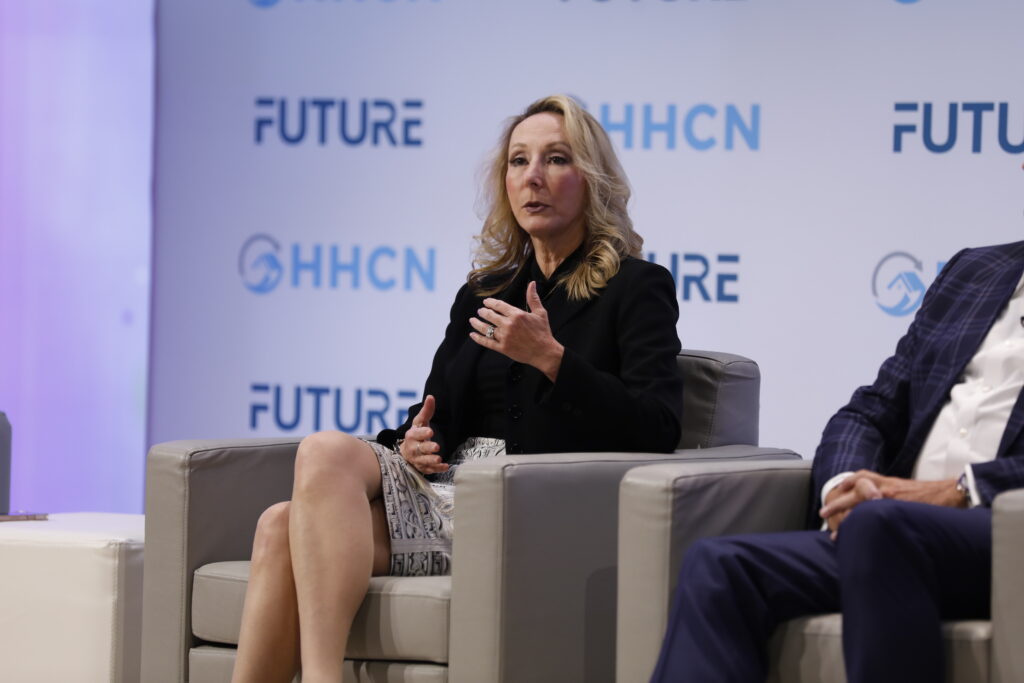In lieu of competing, home-based care providers may need to work together in order to keep up with the growing demand for services.
Companies can do that by finding unique ways to deploy caregivers and leverage certain technologies to increase productivity.
“We were challenged before the pandemic and we’ve certainly been challenged through the pandemic,” Home Helpers President and CEO Emma Dickison said last week at Home Health Care News’ FUTURE event. “Supply and demand is out of balance. It’s one of the biggest challenges facing our industry and we’re trying various ways to solve it.”
The Cincinnati-based Home Helpers is a home care franchise that provides personal care, nutrition and companionship services, among others. It serves over 1,000 communities in the U.S.
A recent study from Home Care Pulse and the Home Care Association of America (HCAOA) – which Dickison is the president of – showed that over 80% of home care offices are turning down clients because of supply.
Home-based care organizations could work together to help solve the issue, Dickison believes. Specifically, she believes they should find ways to “workforce share.”
“It’s an optimization issue, an efficiency of the marketplace issue,” Axxess President and CEO John Olajide also said at FUTURE. “There are some organizations that may have a lot more caregivers than patients, some have a lot more patients than caregivers. What we have found is providers are so married to the idea that this person has to be my employee and has to work for me.”
The Dallas-based Axxess is a home health care technology company.
Instead, providers should hone in on using workforce sharing and technology to minimize the effects of staffing shortages, Olajide said.
“The workforce share has been here. It’s already here,” Dickison added. “At least it has been in my world for a long time. And bringing in technology to be a partner in that will make it easier for the end user, which is the consumer.”
Finding value in a growing market
For Modvicare Inc. (Nasdaq: MODV), the idea of workforce sharing is also not new. The company saw that opportunity years ago, Brett Hickman, the chief commercial officer at Modivcare, said at FUTURE.
Modivcare delivers non-emergency medical transportation (NEMT), remote patient monitoring, meal delivery and personal home care services.
The company made strategic investments in home-based care when others in the market were pulling back. Hickman credited Modivcare’s COO of personal care, Mia Haney, for integrating the company’s leadership team and making sure they had a seat at the personal care services table.
“The math is really simple,” he said. “NEMT is about a $6 billion industry, and now you take the assets that we have today and in the next five years, we’re talking about a $100 billion addressable market of which $55 billion of that is personal care services. Our role in health care delivery is really supportive care. We’re really in that space to support the clinical side of the organization.”
There has been a lot of talk about how rates can affect the bottom line for home care agencies from different payers, but Hickman believes that providers should instead be focusing on the value they can provide.
“We’ve got to stop talking about rates and start talking about the value we’re going to deliver, and how we are actually going to improve the lives of the members we committed to,” Hickman said.
That’s where technology comes into play.
“We’ve leaned into technology a lot,” Dickison said. “One thing that we’ve done is that we’ve created better reporting that can highlight where we have gaps in utilization. Through technology, being able to provide families updates on their loved ones’ care, we think is critical.”
Companies like Modivcare can leverage technology by optimizing routing for caregivers, for instance.
Technology can also improve efficiency, and flexibility continues to be a top priority for caregivers in today’s world.
“We always hear flexibility, flexibility, flexibility today,” Dickison said. “Having to flex towards that is something we’ve had to learn along the way.”
Olajide echoed those sentiments.
“You can leverage technology, you can have protocols, but give the caregiver the flexibility where they don’t have to drive an hour to go see a patient when there are patients in their neighborhoods,” Olajide said. “That’s an opportunity from the technology perspective that is connected to your workforce.”
Through technology, providers like Home Helpers have also been able to rely on informal family caregivers.
“It’s a partnership,” Dickison said. “Most of our clients are not receiving 24/7 care in the home. They’re receiving a level of hourly care throughout the home and then it’s the family. Being able to provide [family caregivers] access to resources and education to support them is really important.”




